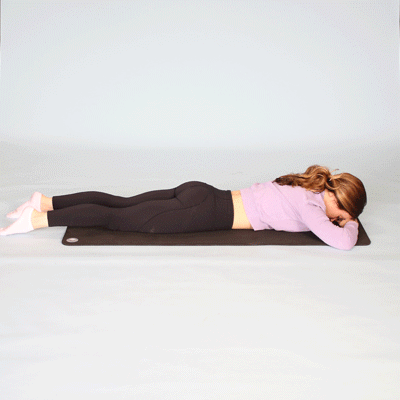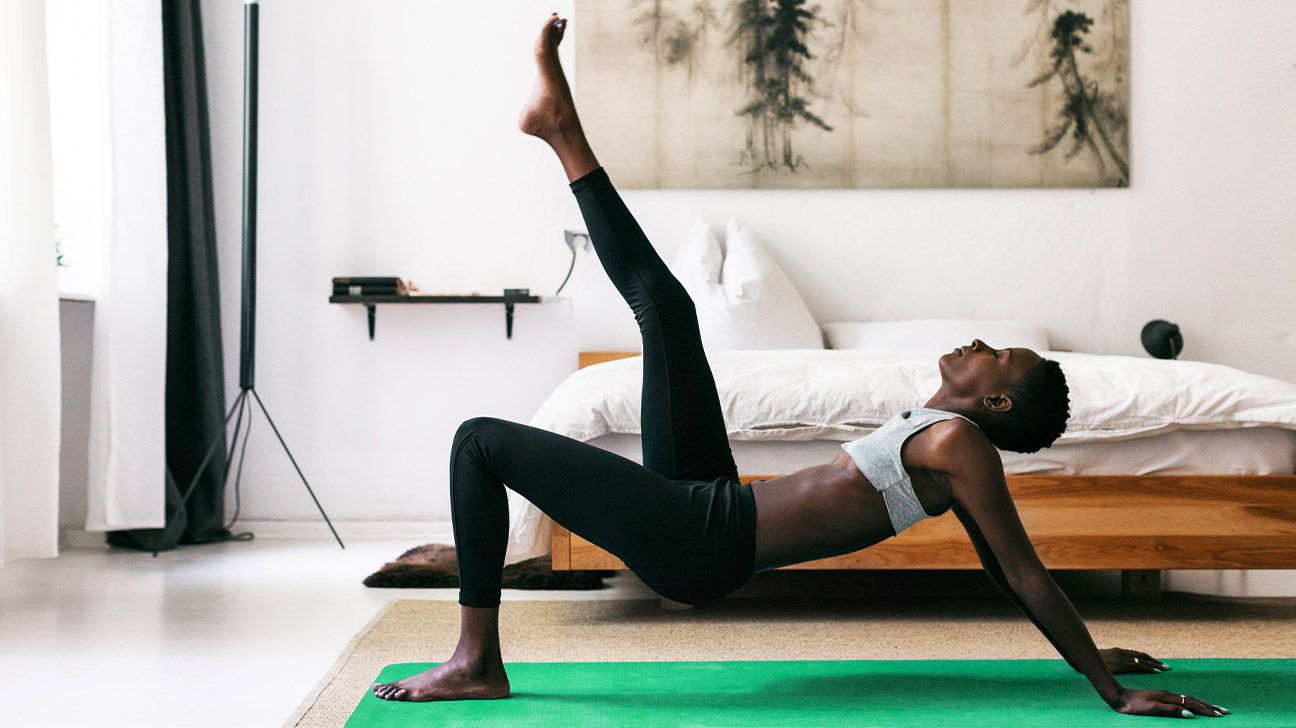The Pilates Single-Leg Kick is a fundamental move, like the plié in ballet. Before you can pull off a Pilates Boomerang (yeah, it’s as intense as it sounds) or glide through the air in a grand jeté like Misty Copeland, you’ve gotta learn the basics.
The Single-Leg Kick stretches your quads while strengthening your glutes, hamstrings, and core. Though it’s a “beginner” move, it’s the perfect addition to any fitness routine. Once you’ve mastered it, you can attempt the Double-Leg Kick.
These moves don’t require any fancy equipment, so grab your Pilates mat and get started.

Step by step: Pilates Single-Leg Kick
- Lie on your stomach with forehead resting on hands and legs touching.
- Slide shoulders down and back. Straighten spine. Fix your eyes on the floor.
- Tilt pelvic bone down and flex your core.
- Raise knees just slightly off the floor. Point toes.
- Bend left leg at the knee. “Pulse” left foot twice (a quick back-and-forth, kind of like a DJ making a record scratch).
- Lower your left leg.
- Repeat with right leg. Do 3–6 reps on each side.
Why do it?
- boosts core strength
- increases flexibility
- improves balance
- improves posture
Step by step: Pilates Double-Leg Kick
- Lie on your stomach and turn head to one side.
- Center hands behind lower back. Rest elbows gently on the floor.
- Tilt pelvic bone down and flex your core.
- Squeeze legs together and extend them back. Lift knees just slightly. Point toes.
- Keep legs together and bend both knees. Pulse feet 3 times toward your booty (which, you’ll notice, is also working hard). Flex hamstrings. Keep pelvic bone glued to the floor.
- Lift chest, neck, and head. Extend hands past your booty.
- Return upper body to the floor. Turn head to the opposite side. Bring hands behind back.
- Repeat on the other side. Do 3–6 reps on each side.
Why double your kicks?
- The Double-Leg Kick offers the same benefits as the Single-Leg Kick and then some.
- Since it’s harder, it’s the ideal next step for someone who’s mastered the Single-Leg Kick.
- Incorporate this move into your routine to improve your balance, core strength, flexibility, and posture.
Step by step: Pilates Front-to-Back Side Kick
- Lie on your side. Keep ears aligned with shoulders, hips, knees, and ankles.
- Prop up head with hand. Lift ribs.
- Rest 1 palm on the floor in front of you. Use this hand to keep yourself stable — not to hold yourself up. To stay steady, squeeze those ab muscles.
- Move legs forward just a bit from your hips. Rotate legs out.
- Lift your top leg and flex that foot. Swing top leg to the front and pulse foot once.
- Point toes and sweep top leg in the opposite direction until it’s extended behind you. Hold it right there for a second, and then return it to center. That’s 1 rep.
- Repeat with your other leg. Do 3–6 reps on each side.
Now, try the Up-Down Side Kick
- To do this version, repeat steps 1 through 4 above. Then, lift your top leg and kick toward the ceiling (instead of to the front). Remember to rely on your abs, not your arm strength, for balance.
- Keep working abs to slowly bring leg back down.
- Repeat with your other leg. Do 3–6 reps on each side.
Why kick at all?
- works your abs
- strengthens and stretches your hips
- improves stride length
- boosts flexibility and walking mobility
Step by step: Pilates Leg Pull Front
- Start in classic plank position (everyone’s favorite torture device).
- Flex abs, lengthen spine, and push your weight through your palms. Stack shoulders on top of wrists.
- Lift 1 leg slightly off the floor (2–3 inches). Point toes and extend leg, careful not to shift out of plank position.
- Return foot to the floor.
- Repeat with your other leg. Do 3–6 reps on each side.
Why do it?
- strengthens your calves
- works your glutes, quads, hamstrings, and groin
- gives your shoulders, arms, and abs a workout
- improves balance and stability
Steps to the perfect Single-Leg Stretch
- Start on your back in tabletop position. Bend knees and keep shins parallel with the floor.
- Flex abs. Extend 1 leg at a 45-degree angle.
- Grasp other leg with both hands around your upper shin.
- Switch legs. Repeat 3–6 times.
Why stretch at all?
- strengthens your abs
- works your booty
- helps improve coordination
- improves flexibility
When Joseph Pilates developed this form of exercise at the turn of the 20th century, he called it “Contrology,” referring to the harmony among the body, mind, and spirit through movement.
As a low impact exercise, it’s perfect for those who want to avoid the wear and tear of high impact workouts like jogging. (If you have injuries or preexisting conditions, always chat with your healthcare provider before trying new exercises.)
Pilates benefits:
- It works your muscles. From arms to abs to glutes, Pilates works muscles throughout your body, giving them a firm and strong appearance.
- It enhances your flexibility. Flexibility means more than doing the splits. It improves your body’s resistance to injury, straightens your posture, and reduces pain.
- It improves your muscular control. If you’ve ever done a new exercise and thought, “Wow, I didn’t even know this muscle existed,” you’re not alone. Working these smaller muscles improves your coordination and muscular stability.
- It boosts your balance. Improving your strength, stability, and flexibility will help improve your overall balance, which is essential for staving off injury.
- It relieves lower back pain. In a 2014 review of studies of people with chronic back pain, researchers found that regular Pilates practice was as effective as massage therapy at improving functional ability and reducing pain.
- It can help with weight management. In a 2017 study of 37 women who were classified as having overweight or obesity, participants saw decreases in weight, BMI, waist size, and abdominal circumference after practicing Pilates for 8 weeks.
A group setting is a great way to get started if you’re new to Pilates. An instructor can make sure you’re doing the moves properly and avoiding potential injury.
If you can’t make it to a class, online instructional videos can help too. Try our 10-minute Pilates core blaster or this 20-minute Pilates workout for any level.
Here are a few more tips for making the most out of your workout:
Is it hot in here, or is it just you? Warm up!
It’s a good idea to warm up your muscles for at least 5 minutes before getting your Pilates on. Doing light exercise beforehand can reduce your risk of strain or injury and help you get the most out of your workout.
A few minutes of light cardio or basic stretches will do the trick. You can also find some ideas here.
Keep in mind that Pilates leg kicks typically show up midway through a Pilates mat class. Patience, young grasshopper — eeease into it!
How to strike a pose
If you watch a Pilates video or take a class, you’ll often hear instructors talk about keeping your spine “neutral.” This means relaxed and straight — neither concave nor convex. A neutral spine lowers your risk of strain or pain and improves efficacy.
If you’re practicing at home, use a mirror to check your poses.
If you feel any strain or pain, just stop, take a break, and try again slowly. Pilates should never cause any sharp pain or discomfort.
Switching things up
Pilates poses can usually be adjusted to suit individual needs. If you have an injury or you’re pregnant, always talk to your doctor and a fitness professional before trying modified moves.
tl;dr
- Pilates is an excellent low impact workout for people of all fitness levels.
- Always warm up for at least 5 minutes before diving into poses.
- Start small with beginner poses like the Single-Leg Kick and do fewer reps.
- If it hurts, stop! This means you need to adjust your technique.
- Talk to your doctor and a fitness professional about modifying poses to suit your needs.


